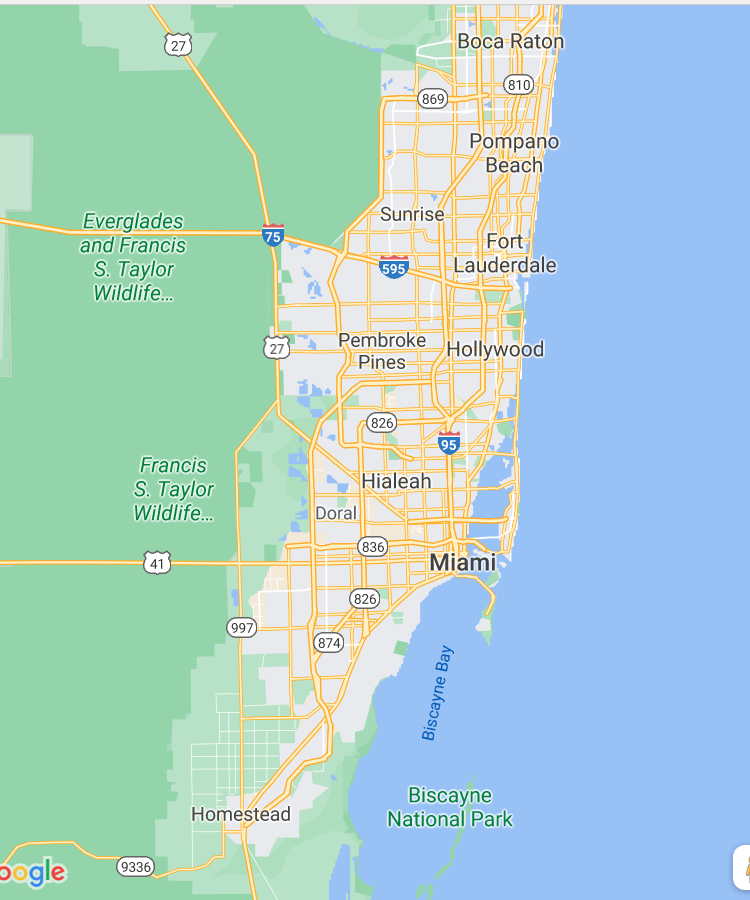From Wikipedia:
Miami is split roughly into north, south, west and Downtown areas. The heart of the city is Downtown Miami, which is on the eastern side and includes the neighborhoods of Brickell, Virginia Key, Watson Island, as well as PortMiami. Downtown Miami is Florida's largest and most influential central business district, with many major banks, courthouses, financial headquarters, cultural and tourist attractions, schools, parks and a large residential population. Brickell Avenue has the largest concentration of international banks in the United States. Just northwest of Downtown is the Health District, which is Miami's center for hospitals, research institutes and biotechnology, with hospitals such as Jackson Memorial Hospital and the University of Miami's Leonard M. Miller School of Medicine.
 The southern side of Miami includes the neighborhoods of Coral Way, The Roads and Coconut Grove. Coral Way is a historic residential neighborhood built in 1922 between Downtown and Coral Gables, and is home to many old homes and tree-lined streets. Coconut Grove, established in 1825, is a historic neighborhood with narrow, winding roads, and a heavy tree canopy. It is the location of Miami's City Hall at Dinner Key, the former Coconut Grove Playhouse, CocoWalk, and the Coconut Grove Convention Center. It is also home to many nightclubs, bars, restaurants, and bohemian shops, which makes it very popular with local college students. Coconut Grove is known for its many parks and gardens, such as Vizcaya Museum, The Kampong, The Barnacle Historic State Park, and numerous other historic homes and estates.
The southern side of Miami includes the neighborhoods of Coral Way, The Roads and Coconut Grove. Coral Way is a historic residential neighborhood built in 1922 between Downtown and Coral Gables, and is home to many old homes and tree-lined streets. Coconut Grove, established in 1825, is a historic neighborhood with narrow, winding roads, and a heavy tree canopy. It is the location of Miami's City Hall at Dinner Key, the former Coconut Grove Playhouse, CocoWalk, and the Coconut Grove Convention Center. It is also home to many nightclubs, bars, restaurants, and bohemian shops, which makes it very popular with local college students. Coconut Grove is known for its many parks and gardens, such as Vizcaya Museum, The Kampong, The Barnacle Historic State Park, and numerous other historic homes and estates.
The western side of Miami includes the neighborhoods of Little Havana, West Flagler, and Flagami. Although at one time a mostly Jewish neighborhood, today western Miami is home to immigrants from mostly Central America and Cuba, while the west central neighborhood of Allapattah is a multicultural community of many ethnicities.
The northern side of Miami includes Midtown, a district with a great mix of diversity ranging from West Indians to Hispanics to European Americans. The Edgewater neighborhood of Midtown is mostly composed of high-rise residential towers and is home to the Adrienne Arsht Center for the Performing Arts. Wynwood is an art district with ten galleries in former warehouses, as well as a large outdoor mural project. The wealthier residents of Miami usually live in the Design District and the Upper Eastside, which has many 1920s homes as well as examples of Miami Modern architecture in the MiMo Historic District. The northern side of Miami also has notable African-American and Caribbean immigrant communities, including Little Haiti, Overtown (home of the Lyric Theater), and Liberty City.